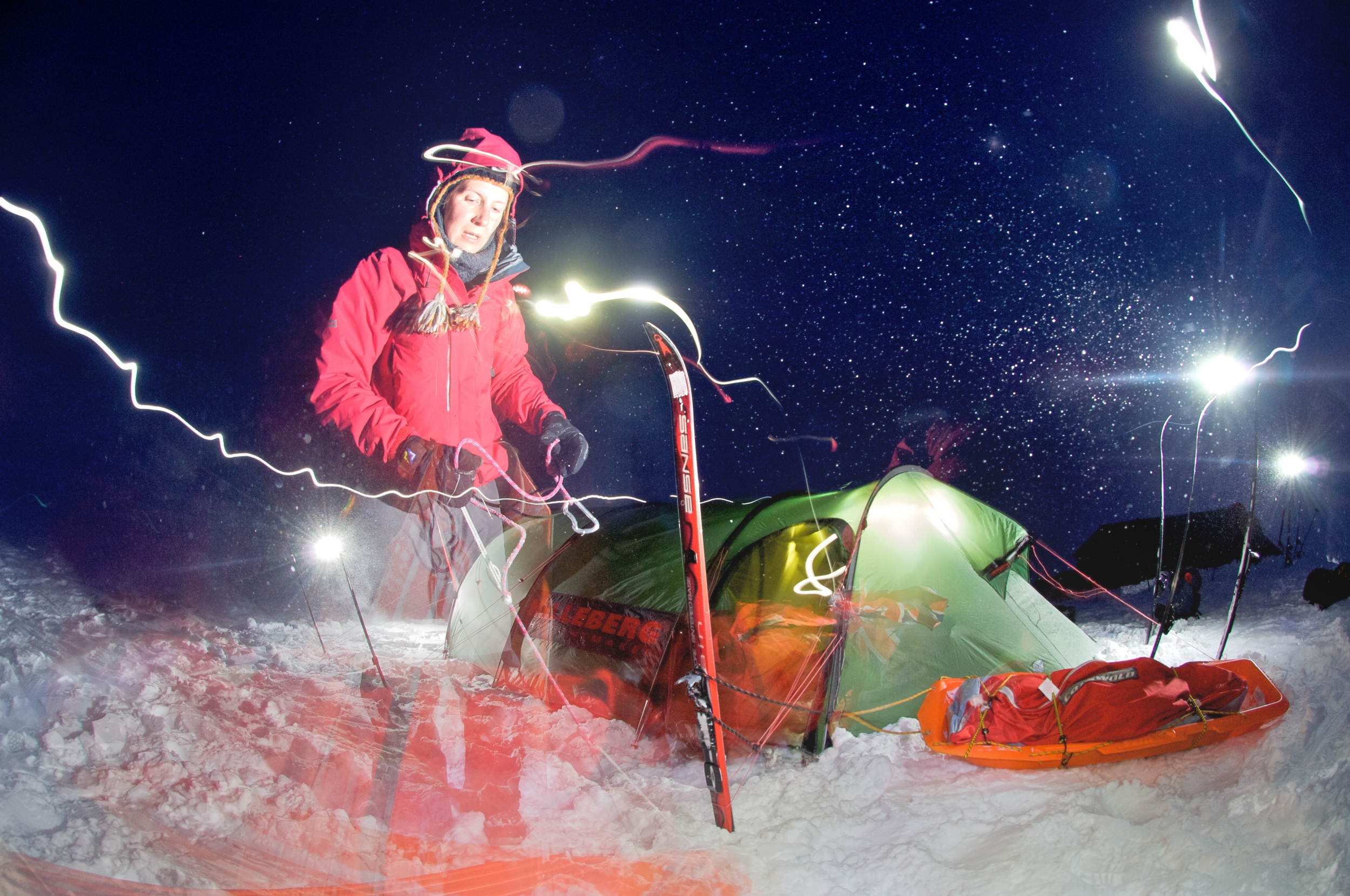
Winter training on the Hardangervidda, Norway
Photo Credit: Robert Hollingworth
Arriving in camp after a day of skiing in blustery weather on the Hardangervidda in February 2009 training the novice members of what was to become the Kaspersky Commonwealth Antarctic Expedition.
I remember feeling so tired as I skied into camp and wondering how much worse all the other women must be feeling. For most of them, this was their first experience of traveling in winter conditions. But in fact, by the time I arrived in camp at the back of the convoy, they were already cosy inside their tents, cooking dinner! It was my first inkling of just how brilliant this group of women was going to be...

Kaspersky Commonwealth Antarctic Expedition
The team of 7 women from 6 different Commonwealth nations skiing over sastrugi on the Polar Plateau of Antarctica some 400km north of the South Pole.
The sastrugi - those strange wave-like formations of snow and ice - don't look like huge obstacles but when trying to ski over them on long free-heeled cross country skis while pulling a sledge, they demand a degree of balance and concentration! The uneven terrain made our daily exertion just that little bit more exhausting physically but were often beautiful to look at.

Guinness World Record
Photo credit: Guinness World Records
I was over-the-moon to fulfill a childhood ambition when my name was added to the book of Guinness World Records in 2013. My certificate now hangs in pride of place at home.
This photograph was taken in a studio for the 2015 anniversary edition after a fun afternoon having fake snow glued to my eyebrows!
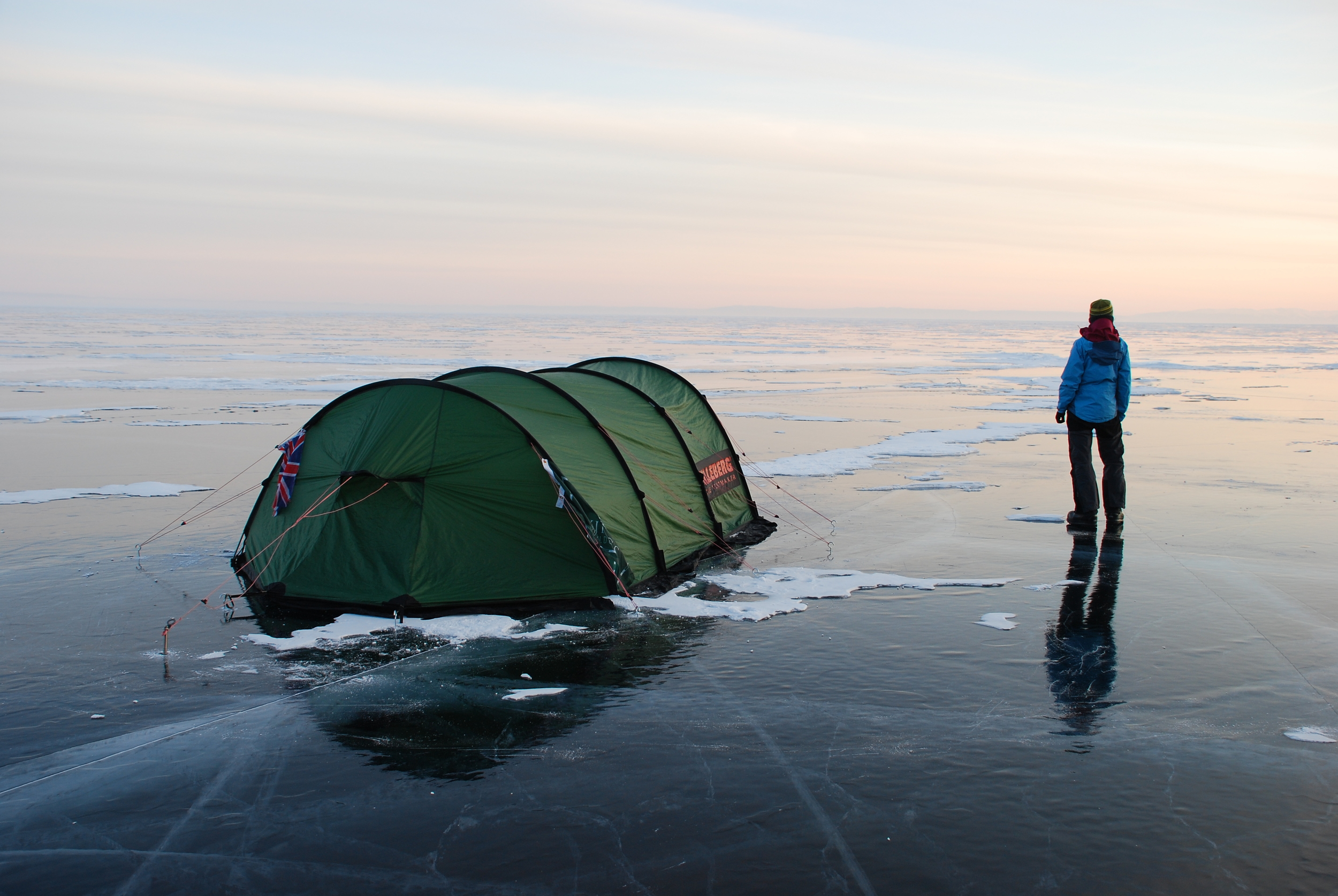
Camping on the winter ice of Lake Baikal, Siberia
Lake Baikal is the deepest lake in the world - no one has ever reached the bottom. This was a disquieting thought as we slept in a tent pitched on meter-thick ice at its surface. All through the night we could hear the gurgle of water and the groan of ice. Even after a month of travel traversing the 700km length of the lake, I didn't get used to it and would wake in the night dreaming of floods!

Driving along the frozen River Lena, Siberia
During a 35,000km journey to the Pole of Cold in northeast Siberia, we drove more than 2000km on the frozen River Lena. It was easy to forget that we were driving on a river.....until we came across reminders like this.
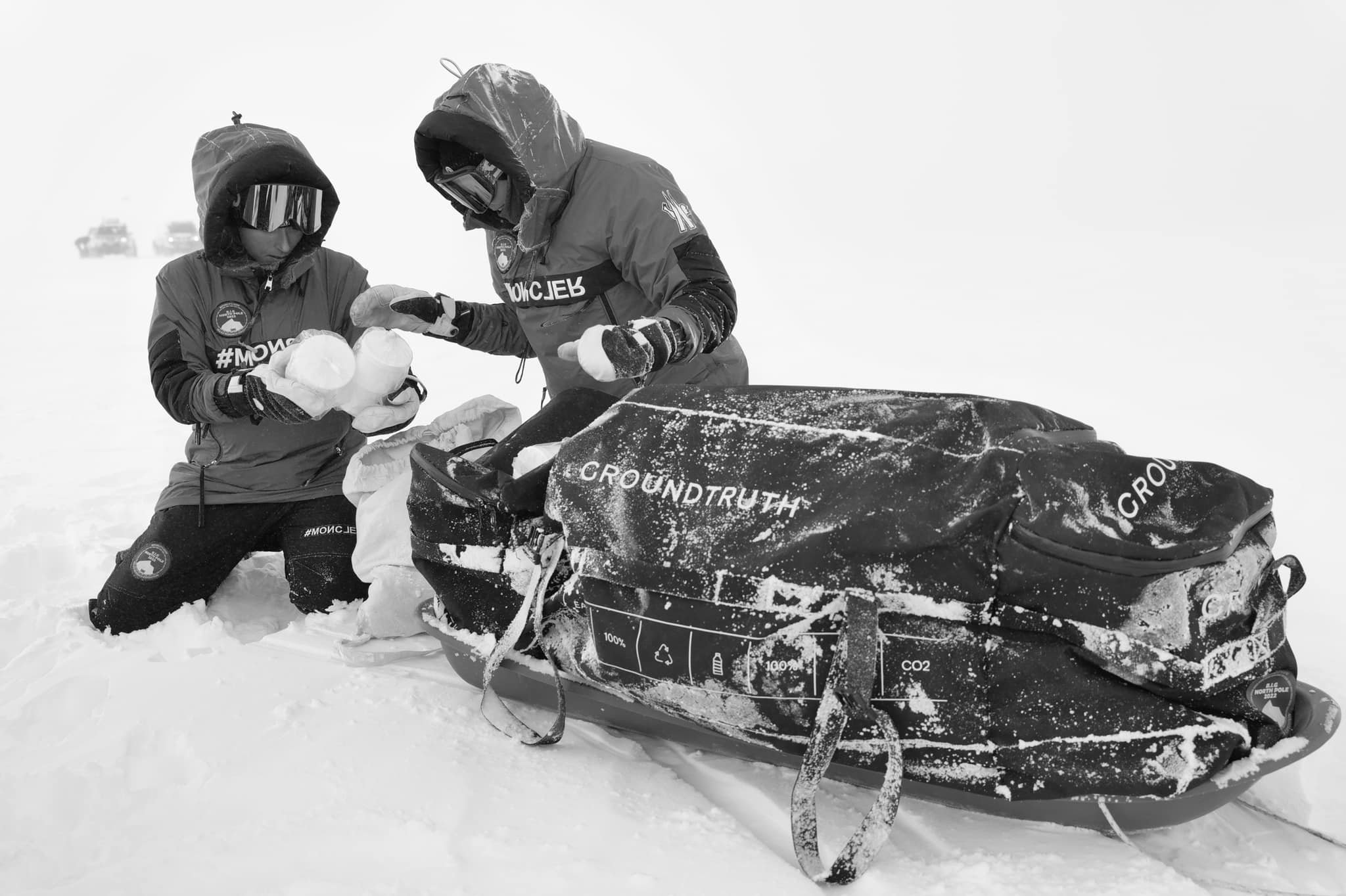
Vatnajökull, Iceland
Photo credit: Sadie Whitelocks
The glacier lived up to its reputation. We’d spent three of our five days on the ice tent-bound in high winds and thick snow, broken only by periods of torrential rain. On our last day we skied through a whiteout but just as the vehicles arrived that were to collect us, the wind dropped and the visibility cleared a little. We took the opportunity to extract some snow and ice samples, stashing the precious containers in our sledges as we plan to do on our way to the North Pole in 2022…

Kaspersky ONE Trans-Antarctic Expedition
Camped within sight of the Ellesworth Mountains on the coast of Antarctica near Hercules Inlet.
After nearly two months alone on the ice, I took this picture on what I thought would be my last day. I was relieved to be nearing the end but also sad and nostalgic that my incredible time with the continent was coming to a close.
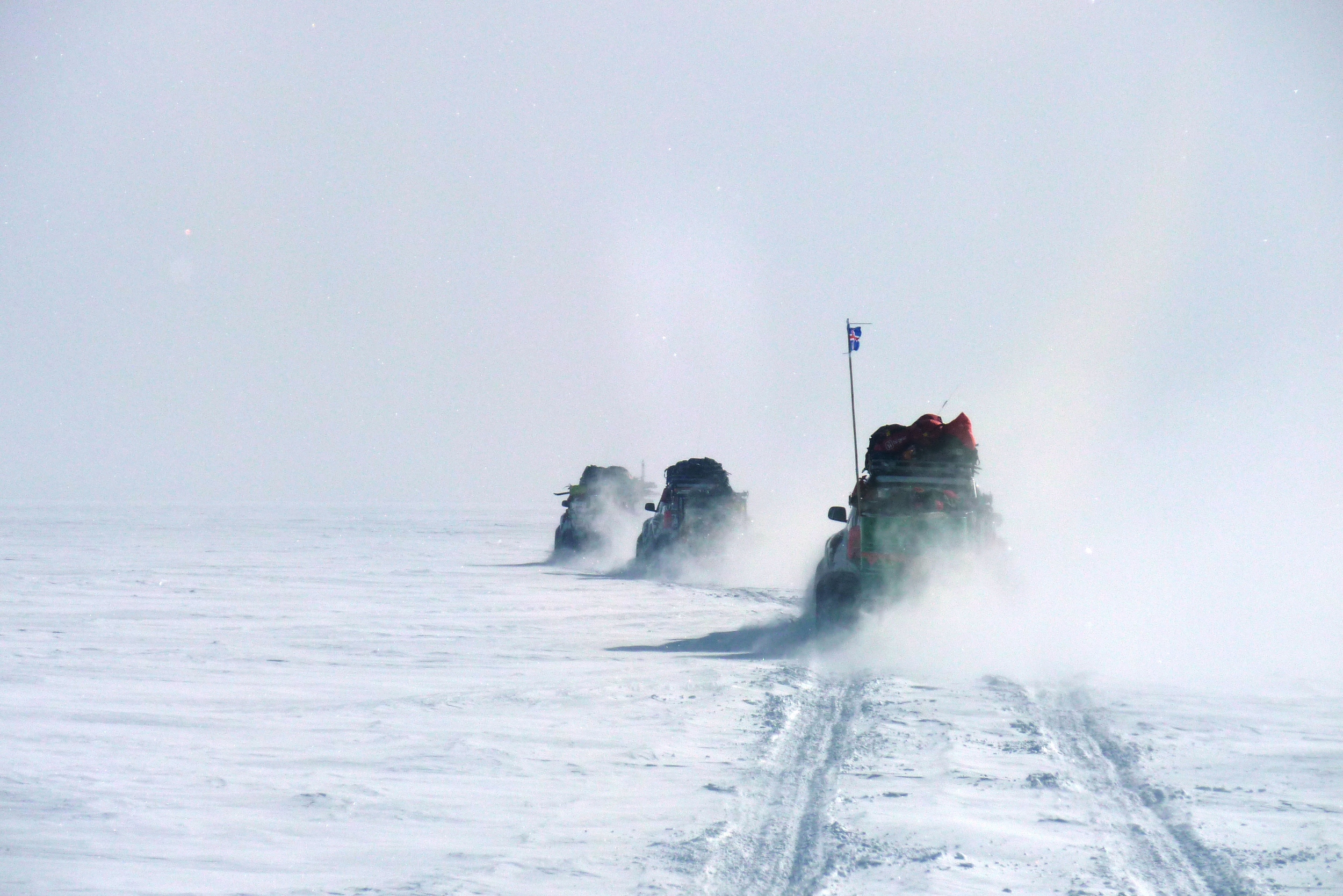
Driving to the South Pole
Icelandic pioneers, Arctic Trucks, established a new route from the coast of Antarctica to the South Pole in 2008/9. In 2010/11 I drove the 6000km return journey with them, from coast to Pole and back, in support of a TV documentary.
In the Icelandic way, we drove the trucks on 44" tyres at less than 5psi, so that it looked as if we were driving on flats. The tyres literally 'float' over the snow making vehicle travel possible. The journey opened my eyes to this new means of transport in the polar regions.
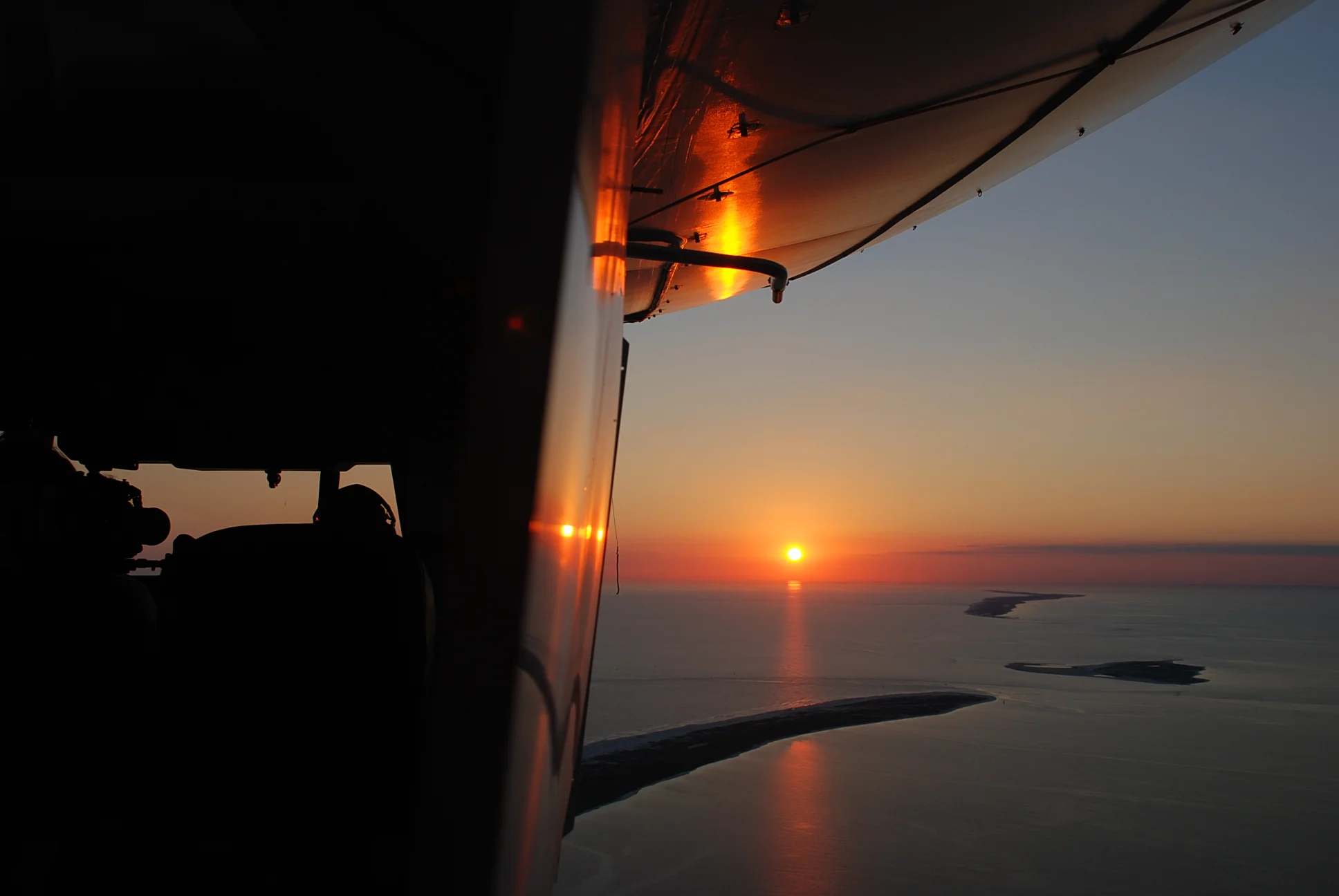
Airship across America
Flying from Cape Canaveral in Florida to Monterrey in California in the worlds largest commercial airship filming a Science documentary about the atmosphere for BBC Two.
The airship was surprising. I thought it would take off gently like an air balloon but in fact it shot up into the air like a rocket. At times it would be buffeted by thermals lifting first the nose, then the tail, in a motion the pilots called 'dolphining'. It made me feel horribly travel sick!

Langjökull, Iceland
Photo credit: Gísli Jónsson
Training for Antarctica on the top of one of Iceland's major glaciers in September 2011, a couple of months before heading South.
The weather in Iceland is always dramatic and often makes the already epic landscape look even more fantastical.
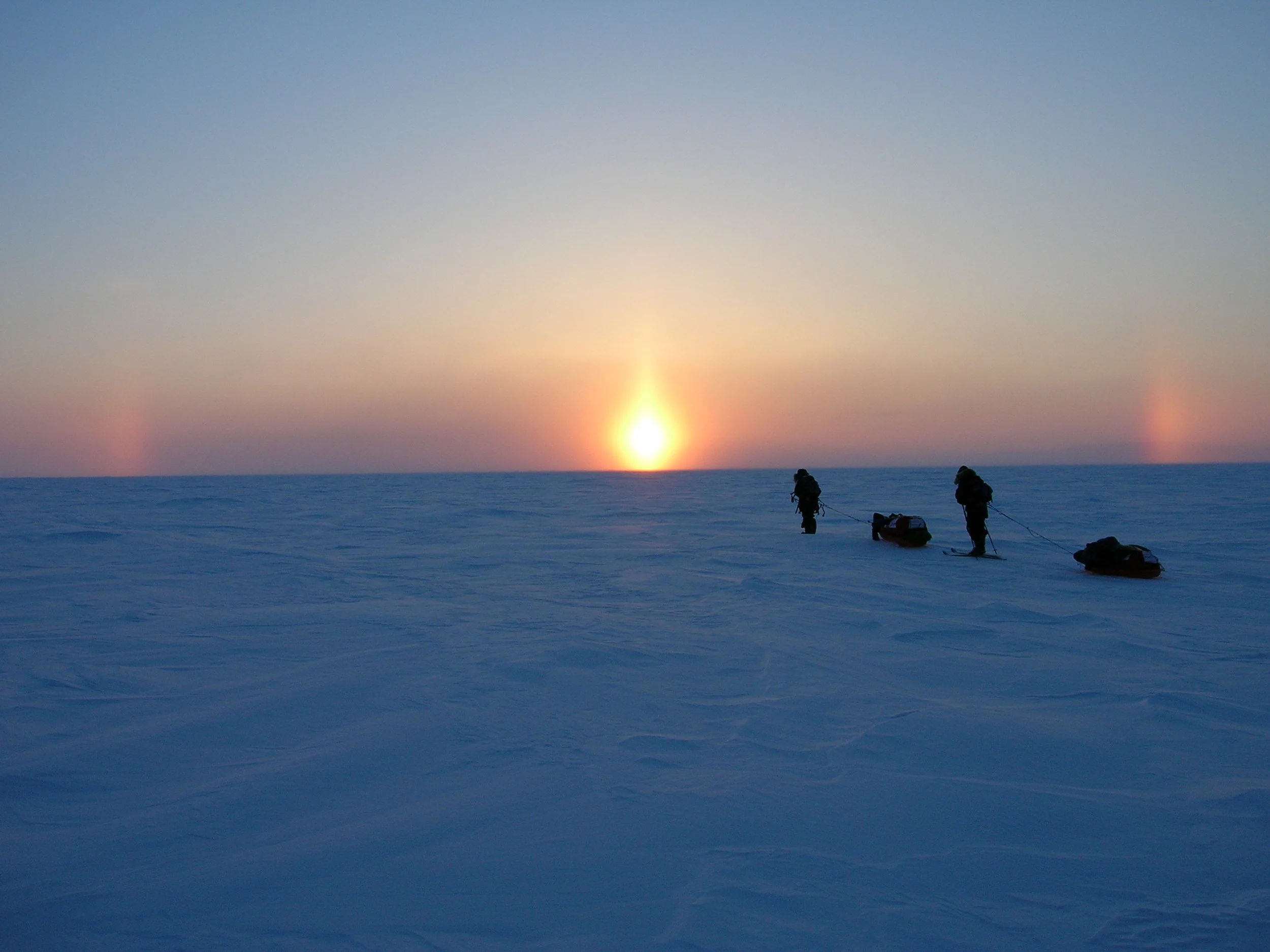
North Magnetic Pole
A ski race across the Canadian Arctic from Resolute Bay to the 1996 position of the North Magnetic Pole. I competed as part of the Pink Lady Polecats and we finished in 6th place out of 16 teams (and as the first all-female team to complete this annual endurance race).
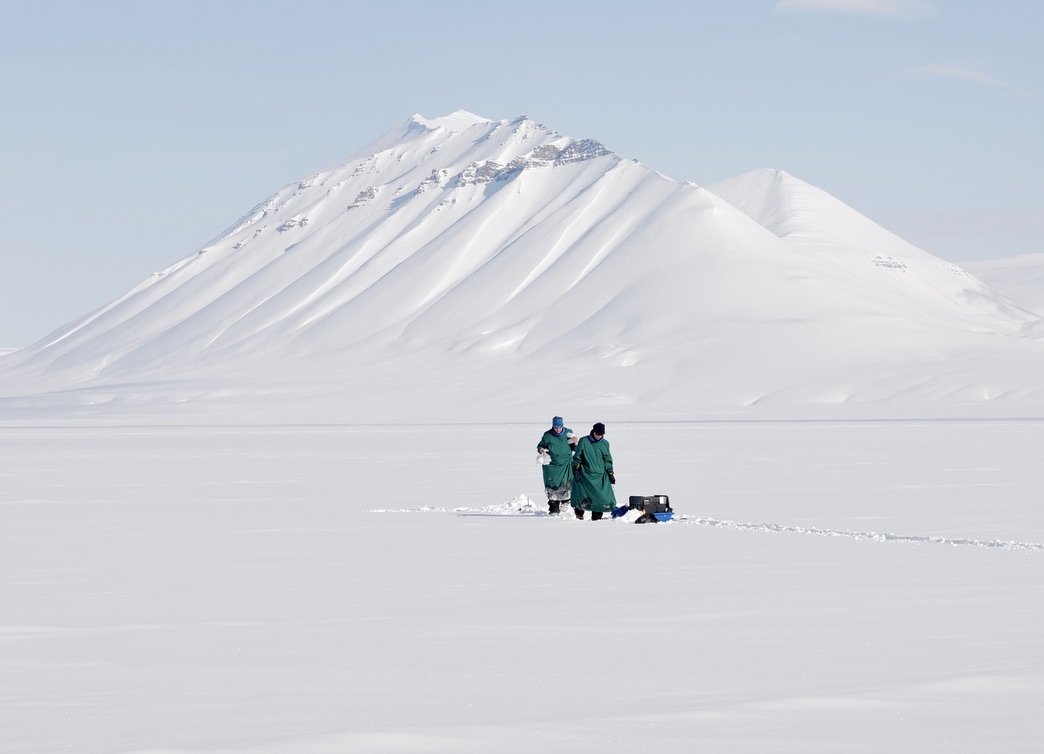
Sampling location 2, Van Mijenfjorden, Svalbard
Photo credit: Sadie Whitelocks
We looked like lunatics out on the ice, dressed in green surgical gowns, leather welding gauntlets and canvas sacks tied around our boots, weilding power tools…but there was logic to our apparent madness. We were sampling snow, ice and water to be analysed for microplastics, heavy metals and black carbon. The outfits were to ensure that we didn’t contaminate the collected samples with pollution from our clothing.
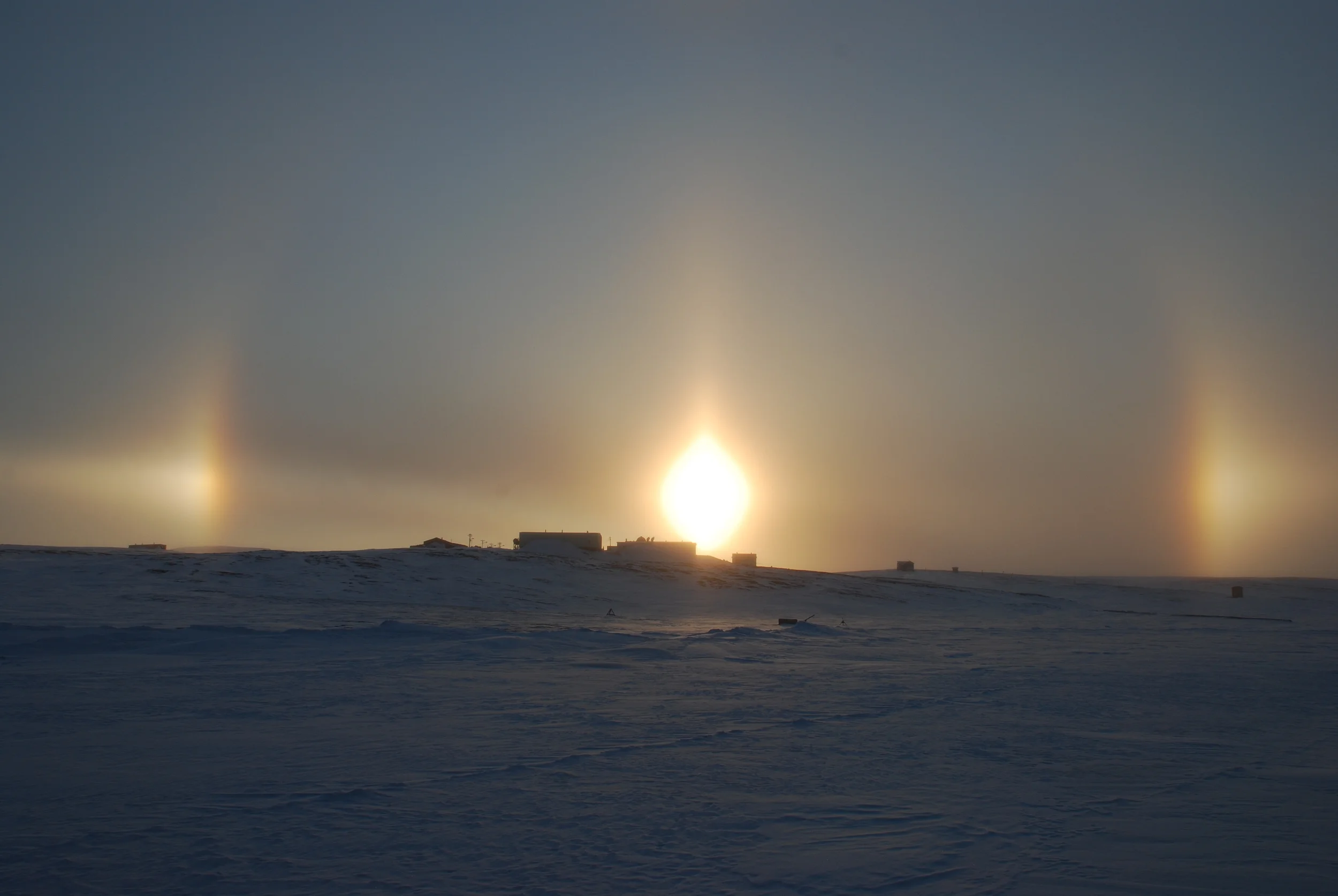
Isachsen Mine, Nunuvut
While setting up a small base camp in the Canadian high Arctic I had plenty of time to explore this eerie Uranium mine that was abandoned in the 1970s. When I first visited, it was still complete with books on the shelves, food in the freezer and crockery on the table - as if the employees had only just left. On return a few years later, I found that visitors had picked the place almost entirely clean by taking mementos.

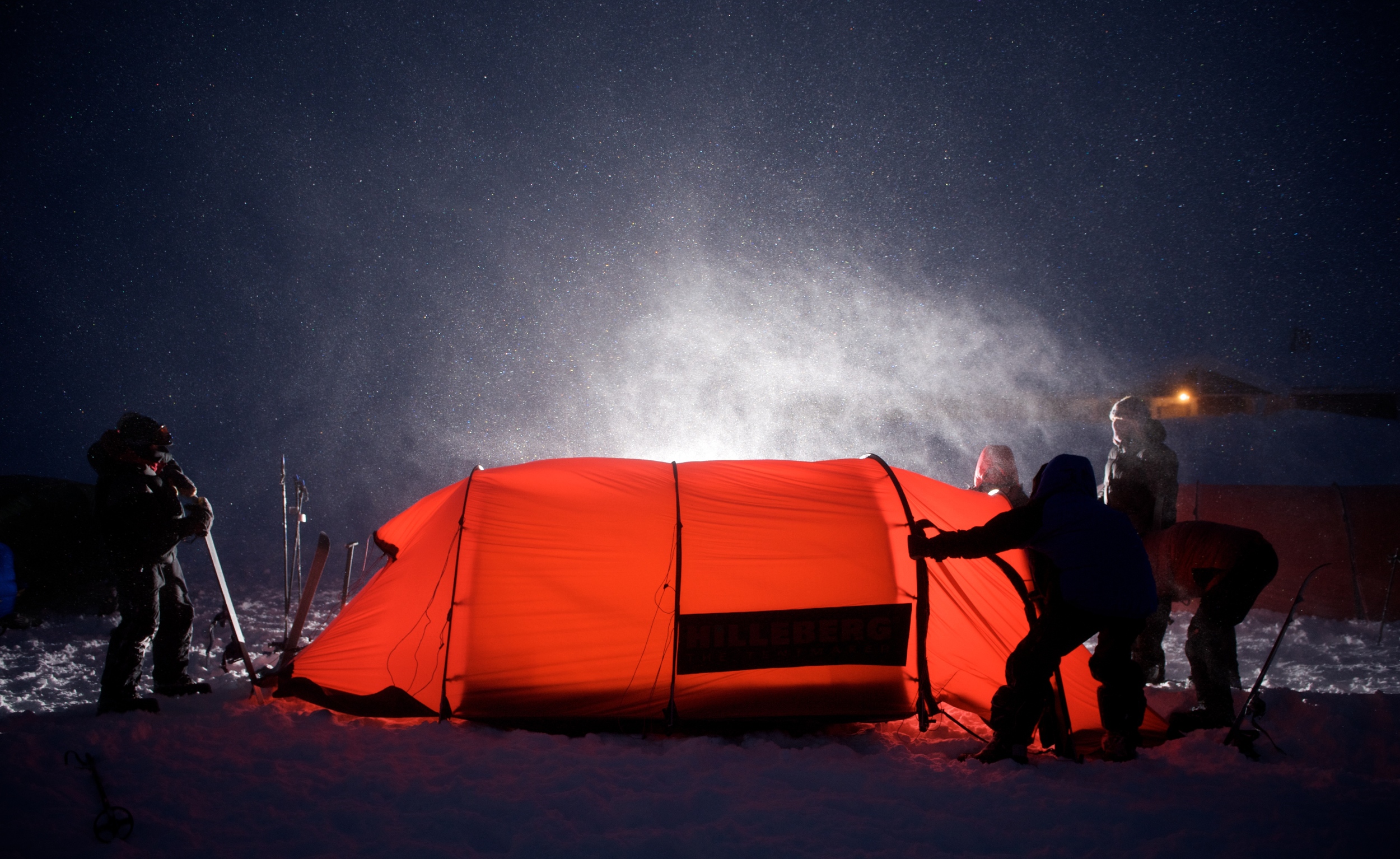
Hardangervidda, Norway
Photo credit: Robert Hollingworth
Tent drills in a blizzard on the Hardangervidda in preparation for the Kaspersky Commonwealth Antarctic Expedition.
Learning in bad weather always makes the real thing a lot easier!
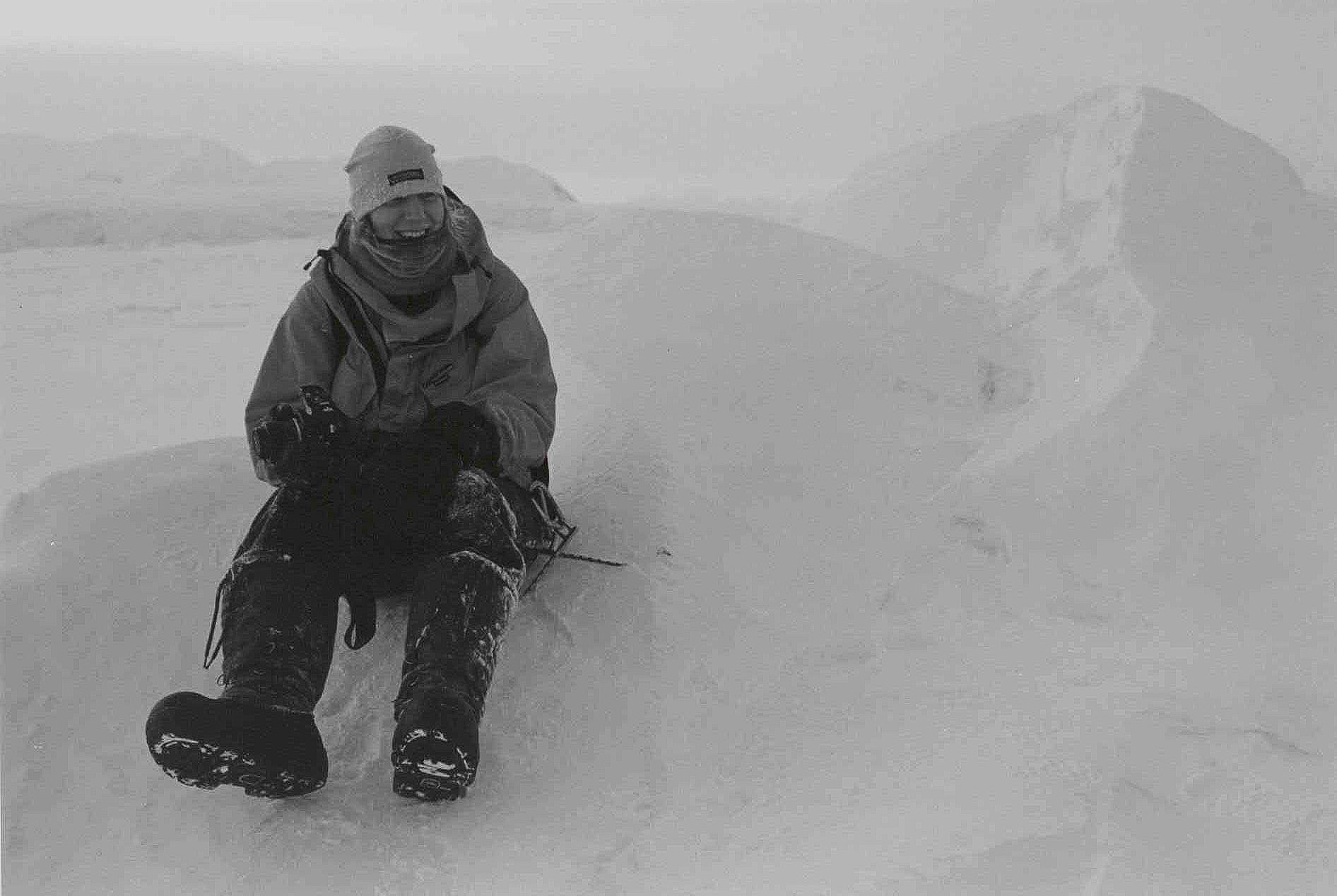
Marguerite Bay, Antarctica
Photo Credit: Tom Marshall
Sitting on a grounded iceberg that had been trapped by sea ice in a frozen Marguerite Bay, close to Rothera Research Station on the Antarctic Peninsula.
Towards the end of a long dark winter on the station, isolated from the world with a crew of just 20, the return of the sun meant that it was easier to go and explore. The grounded icebergs had become local landmarks to us. The ice was often opaque and a surreal duck-egg blue. To me they always looked like stage scenery - even thought they were definitely the real thing!

The western edge of the Greenland ice-sheet
We had set out from this spot some 31 days beforehand. Returning, having skied more than 1100km to the east coast of the ice-sheet and back, we found the landscape completely unrecognisable. The amount of melt was astonishing and the new terrain made travel extra challenging. Finding a route through the hummocks and rivers felt like negotiating a maze with no solution.

Vilyuiy River, Republic of Sakha
A 150km ski along a frozen river in north-east Siberia to follow the trail of a Victorian British nurse who had travelled to the region in search of a cure for leprosy.
The river was beginning to thaw and while some patches had refrozen a solid ice crust, other places were distinctly soft. Slava, our Yakut guide, was not very impressed by the whole undertaking...

The Arctic Ocean
During the summer months, the Arctic pack-ice begins to melt and pools of meltwater form on its surface creating a spectacular pattern that I only truly appreciated once I had seen it from the air. This picture was taken in August, which is when the melt is pretty much at its greatest extent.

Lake Teletskoye, Republic of Altai
Photo credit: Gísli Jónsson
It was early morning and the sun was shining for the first time in what felt like forever. We had been travelling across Eurasia for nearly 3 months, squashed into a cramped vehicle. It was the perfect moment to put on some skis and head for the horizon.

Greenland Ice Sheet
On our way to becoming the first British Women's team to cross the Greenland ice sheet.
A few moments after this photo was taken we came across a small bird sat on the snow. When we paused, the bird hopped onto a sledge and sat there happily as we dragged it along!
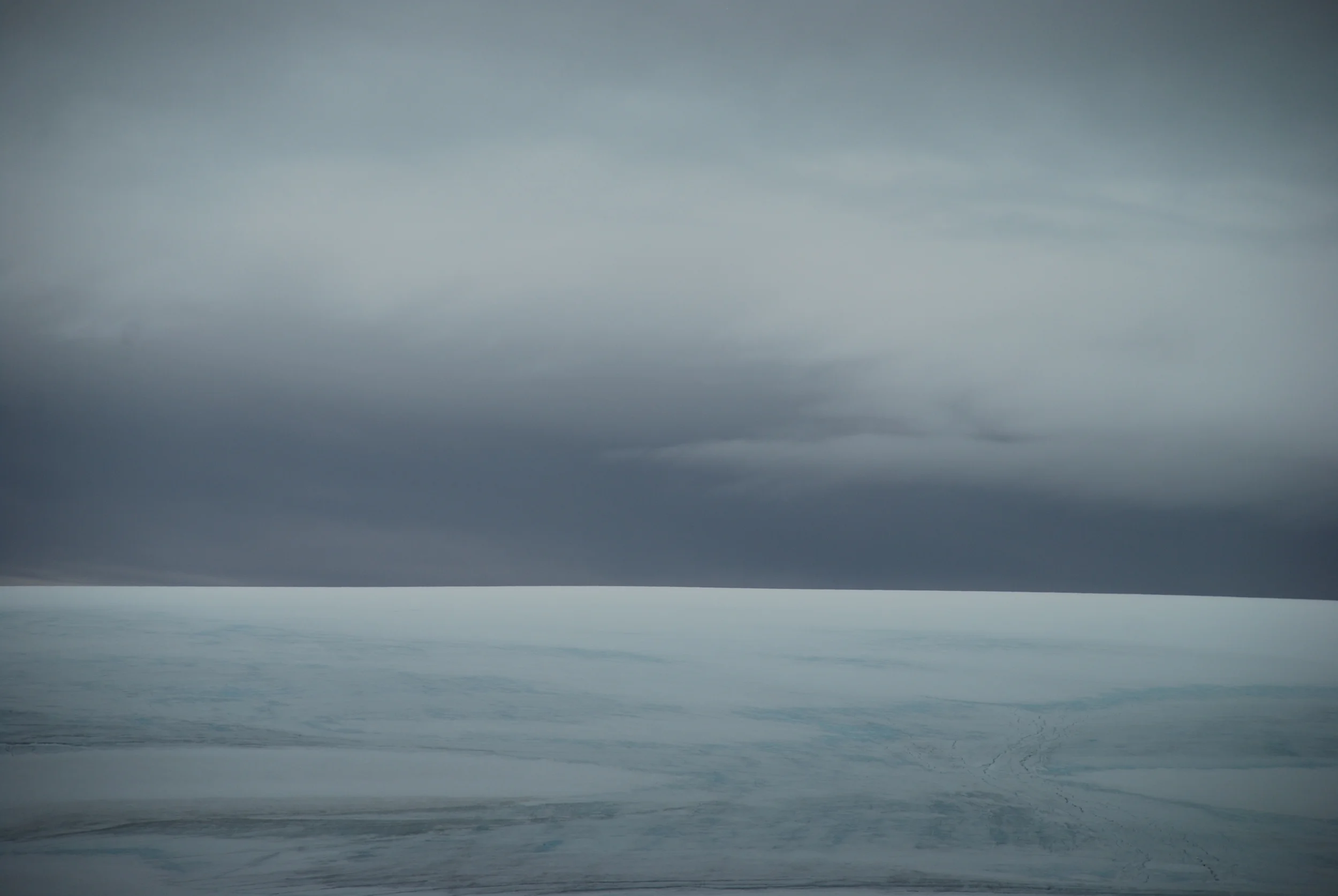
Northbrooke Island, Franz Josef Land
Franz Josef Land is a scattered archipelago of islands in the Arctic Ocean. It is perhaps one of the most isolated places on the planet and yet it is at the heart of so much Polar History.
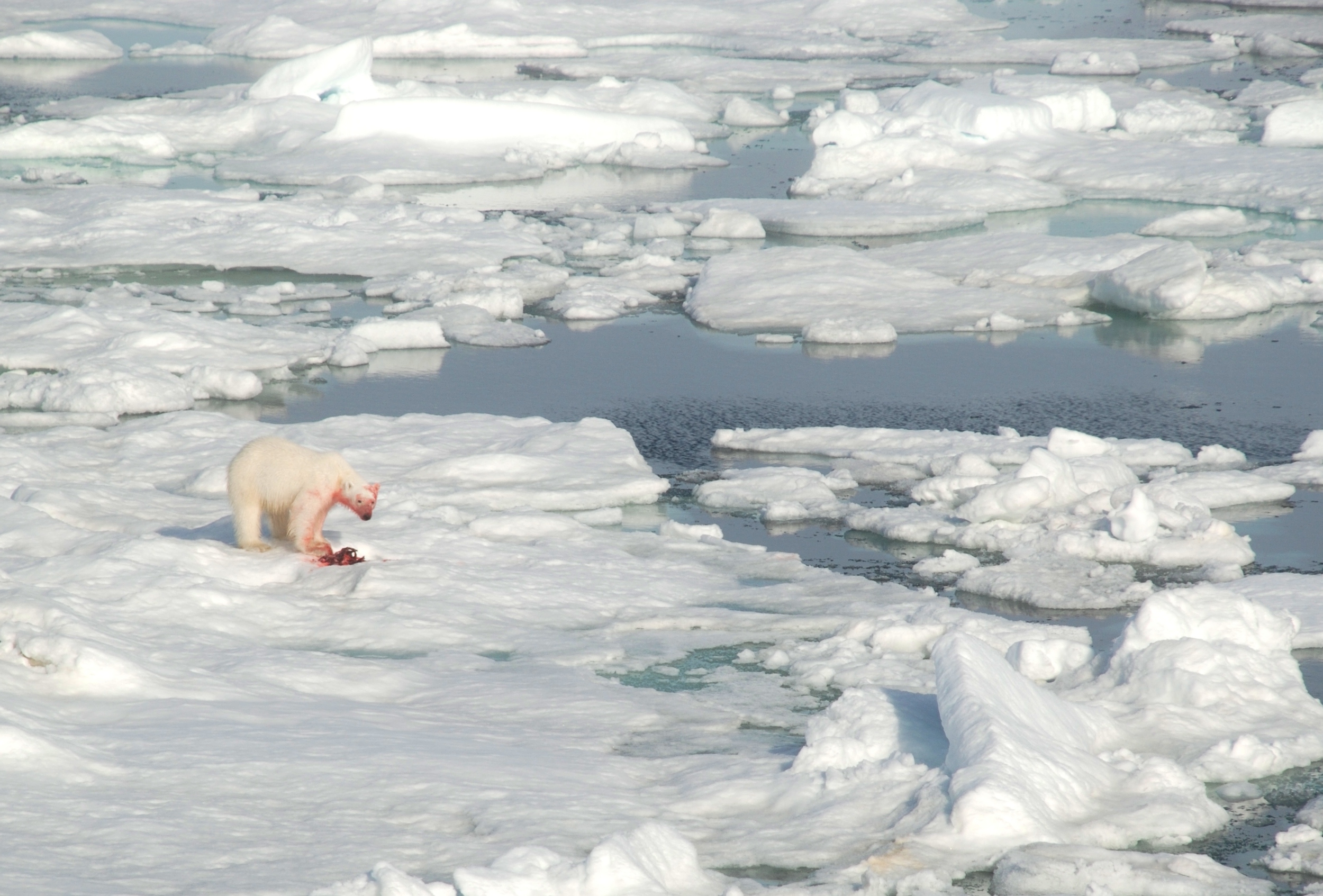
Polar Bear, Arctic Ocean
Scanning the pack ice with a pair of binoculars I announced to my companion, 'I can see a lump of ice that looks exactly like a Polar Bear watching us...'
It's amazing how difficult it is to spot a Polar Bear.
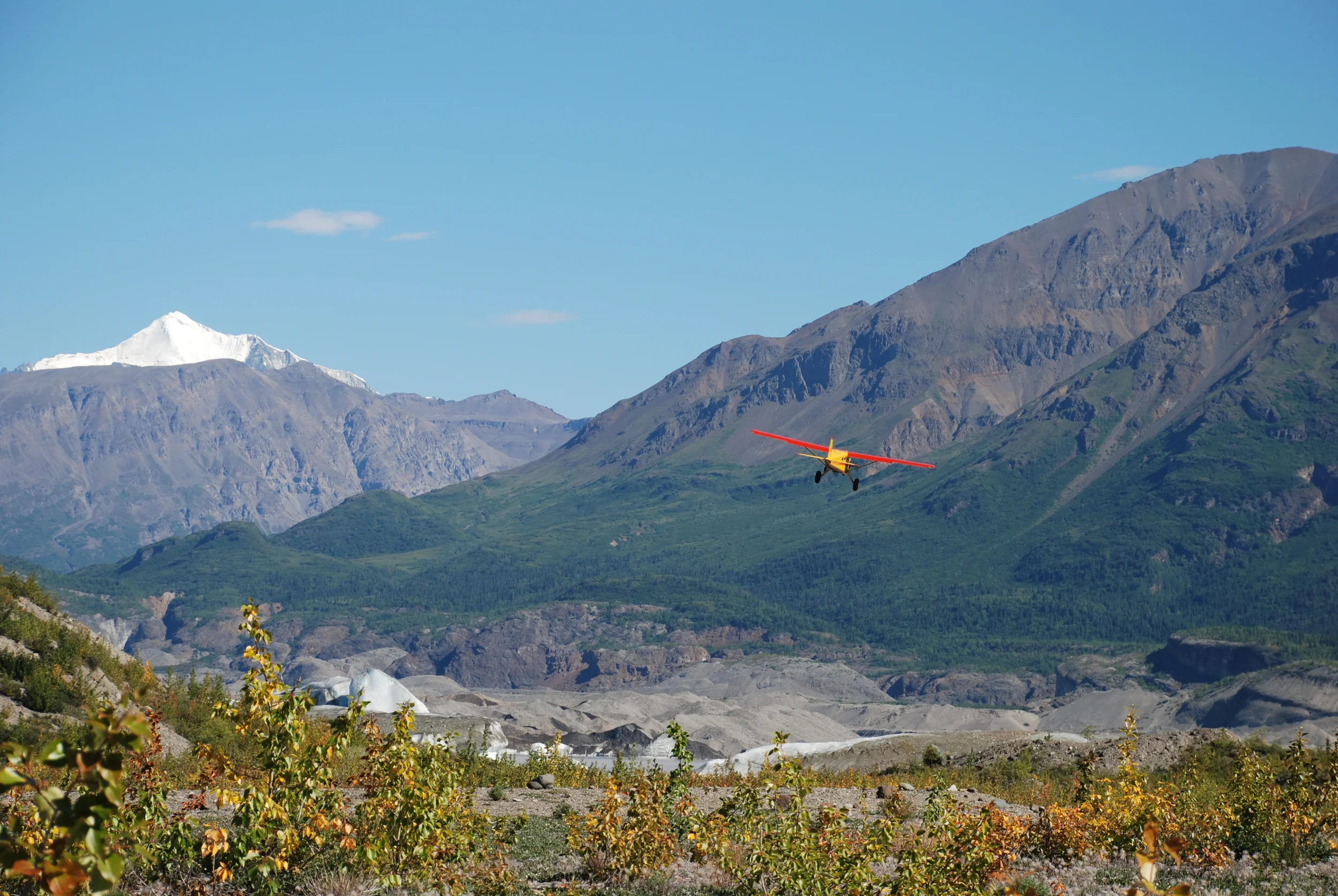
Wrangell-St Elias National Park, Alaska
The bush plane had just dropped us off at the head of the Nizina River for a 10-day rafting trip. The mud-brown headwaters of the Nizina were choked with icebergs calved from the local glaciers.
I think about this place whenever I hear anyone say, 'The world is a small place'. The scale of the wilderness in Alaska, as in many other wild places of the world, is hard to comprehend. We have lots left to discover....

Queen Elizabeth Islands, Nunuvut
The islands of the high Arctic in Canada are magical places. Spending some time manning checkpoints and a base camp around Ellef Rignes Island and Bathurst Island taught me that what looks like a very sterile, frozen landscape is actually full of miraculous life. From grasses and lichens, to lemmings and wolves - it is incredible how life survives this harshest of climates.

Gerlache Strait, Antarctica
4am and the sun lingered low behind the mountain peaks that lined the flat calm strait of water. The low light filtered bronze and violet through the ice and water of the landscape, floating bergs radiating striking turquoise while the cloud blushed indigo. For a moment all was still until a rush of wind blown by a whale cut through the air - orca. A copse of fins rising proud and erect, slicing through the tide. I counted three, no five. Another four nearby. Away in the distance, two close apart. A further group of four. A whole extended family of orca enjoying the still water, the young rolling to reveal fins, or slapping water with their tails while the matriarchs steamed onward porpoising through the swell.

Drangajokull, Westfjords, Iceland
Photo credit: Julie Moniere
Each box contains snow samples taken from five different locations across the glacier. The samples will be analysed for microplastic, heavy metal and black carbon content. To collect them had involved battling fist too little snow to access the glacier, then too much, had required donning clean suits in blizzards and kneeling in the snow for hours facing into the wind. Traversing the glacier was an achievement but returning with these boxes was the bigger source of pride.
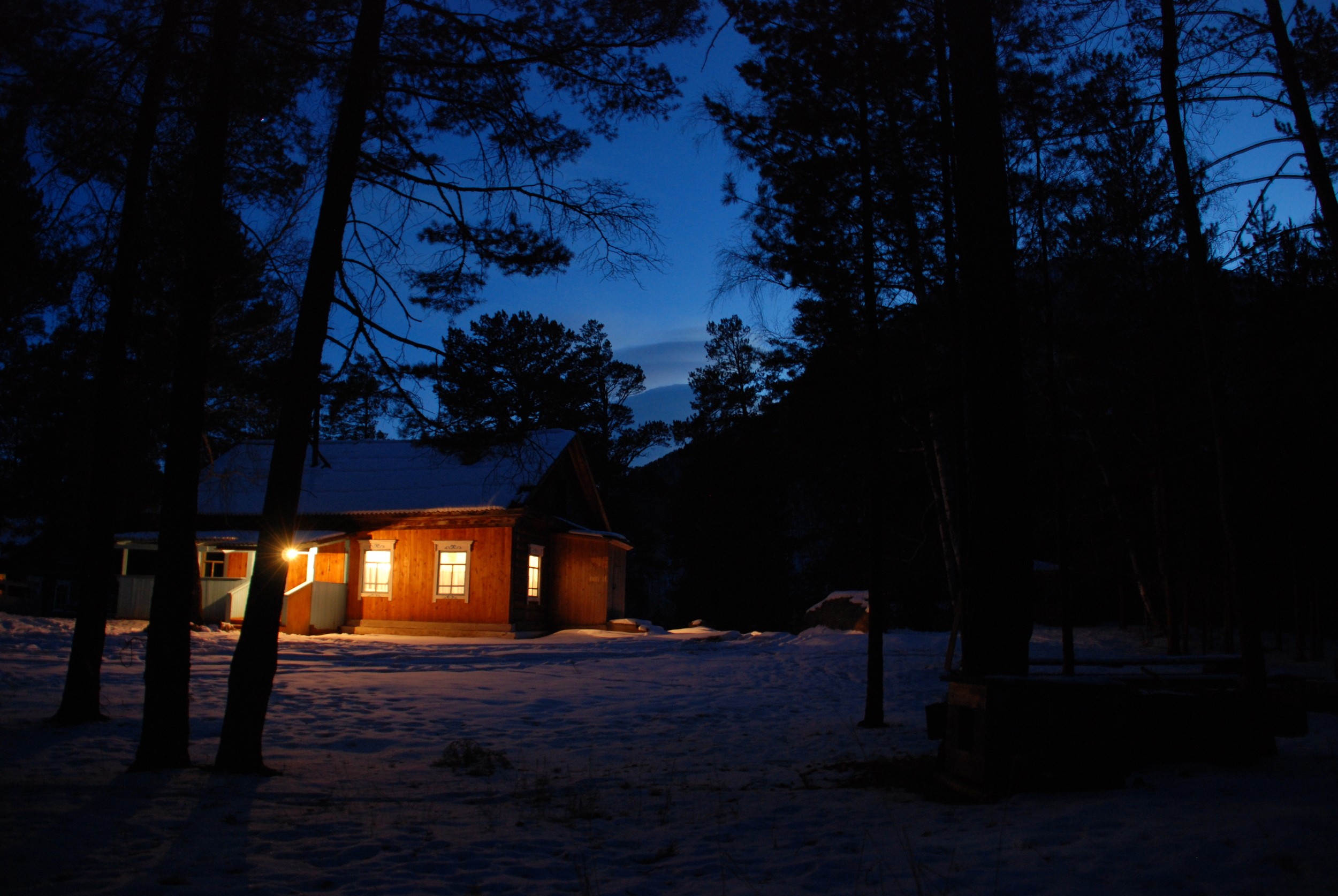
Alli, Barguzin Valley, Republic of Buryatia
Having set out from Ust-Barguzin, the town at the mouth of the valley, this small hut was as far as we could go, the end of the line. Beyond were mountains and untravelled wilderness.
I spent ages outside with my camera on a tripod, trying to capture the light of the evening and the cosy appeal of the hut. The air was completely still so I could hear every rustle in the forest and the laughter of the company inside floating out to me.

Eveni Camp, Yakutia, Siberia
We had been searching for the Eveni for days. 'You never know exactly where to find them,' said our Yakut guide Slava. 'That's the trouble with nomads.'
Eventually we saw the tell-tale spiral of wood smoke rising from the forest and it led us straight to the camp of this small family of Eveni reindeer herders. The dog didn't like our arrival much but everybody else treated us to the warmest of welcomes.

Republic of Tuva
Tuva is a tiny republic within the Russian Federation, pressed hard against the Mongolian border. It is a very spiritual place. Any spot that is considered to have special energy or significance is festooned with brightly coloured strips of material - probably an adaptation of the Buddhist prayer flag tradition. Locals leave small offerings such as coins, cigarettes, small gifts or alcohol at these places. We adopted the custom as a sign of respect, leaving whatever we had that was of worth to us, perhaps a chocolate or a piece of fruit.
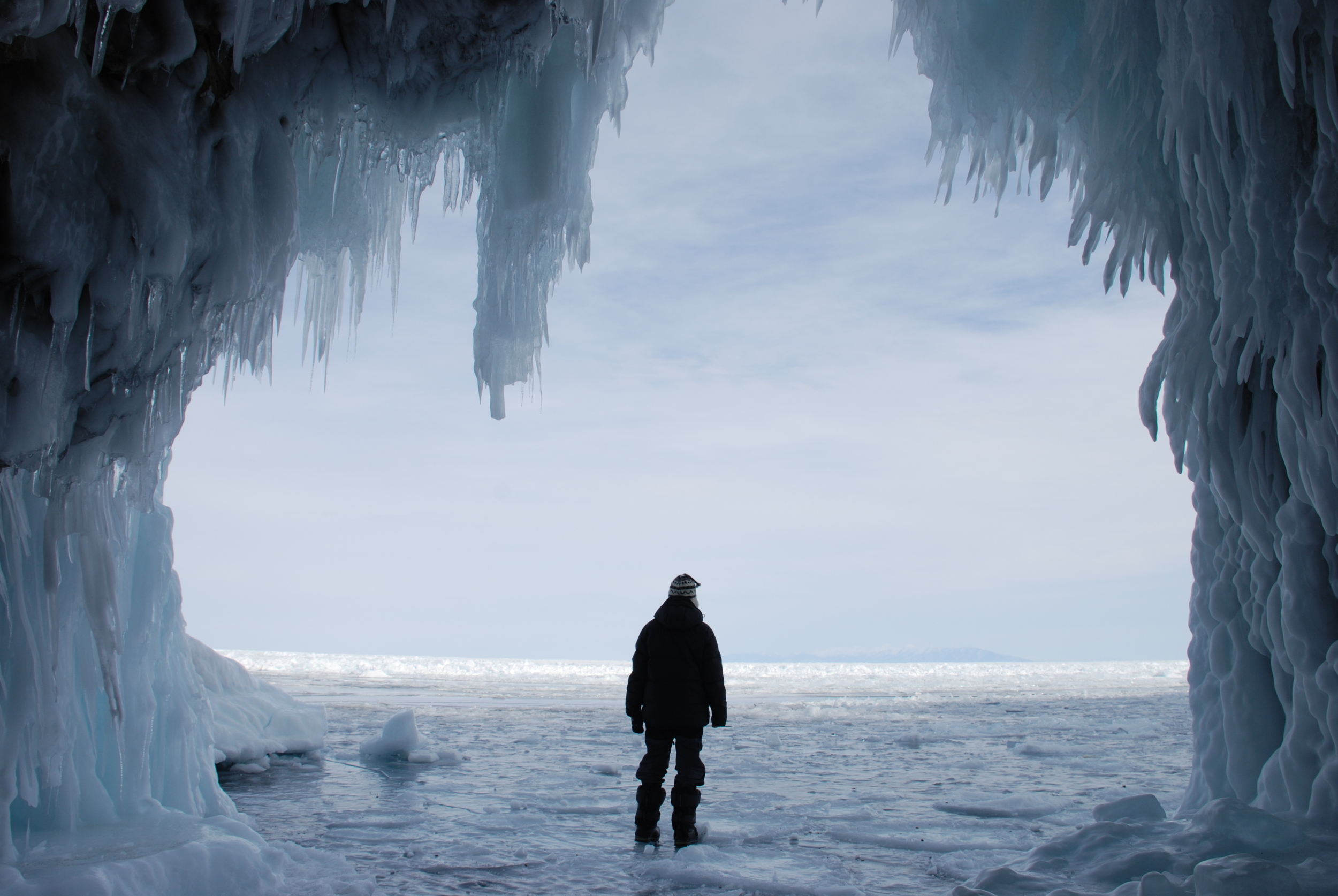
Cape Khoboy, Olkhon Island, Siberia
The very northern tip of Olkhon Island is one of the most spiritual places in Buryatia for local Buryats. For me, it was a very surreal place. Arriving in winter, we could walk around the bottom of the sheer cliffs that surround the Cape and explore the folds in the rock.
I found this cave, festooned with frozen spray. It felt like a movie set.

Lofoten Islands, Norway
In the summer time the Lofoten Islands are an extremely popular beauty spot that is crammed to bursting with holidaying Norwegians and overseas tourists. However, come winter time, the islands are empty. And yet, I think they are just as beautiful (if not more so) in wintertime than they are the rest of the year...

Memories and Experiences shared...
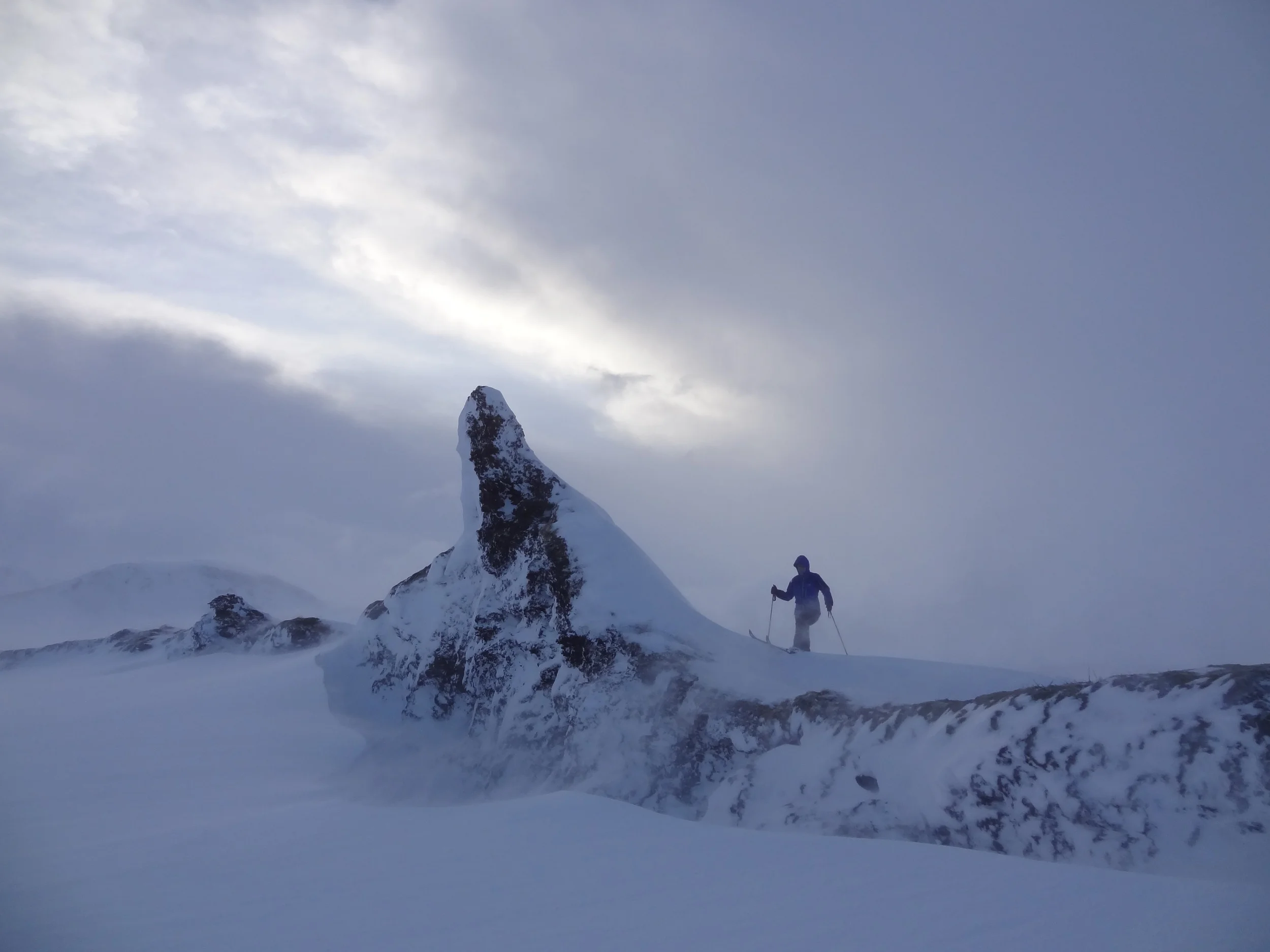
The Central Highlands, Iceland
Photo credit: Gísli Jónsson
Local tradition has it that giant Trolls once roamed the central highlands of Iceland. The trolls could only travel at night and had to be home before dawn. If they were caught out in the open, the first rays of sunlight to creep over the horizon would turn them to stone.
It is easy to spot the unfortunate trolls who were late getting home - they are littered across the landscape...

Rypefjord, Scoresby Sund, East Greenland
A snow-smeared morning proved to be the perfect day to be on the water in a small boat. Visibility was low but there was no wind and the water was glassy.
Rypefjord is a small branch of the larger Scoresby Sund fjord complex, the largest by area in the world. The scale and the emptiness of this East Greenland coast is hard to comprehend.
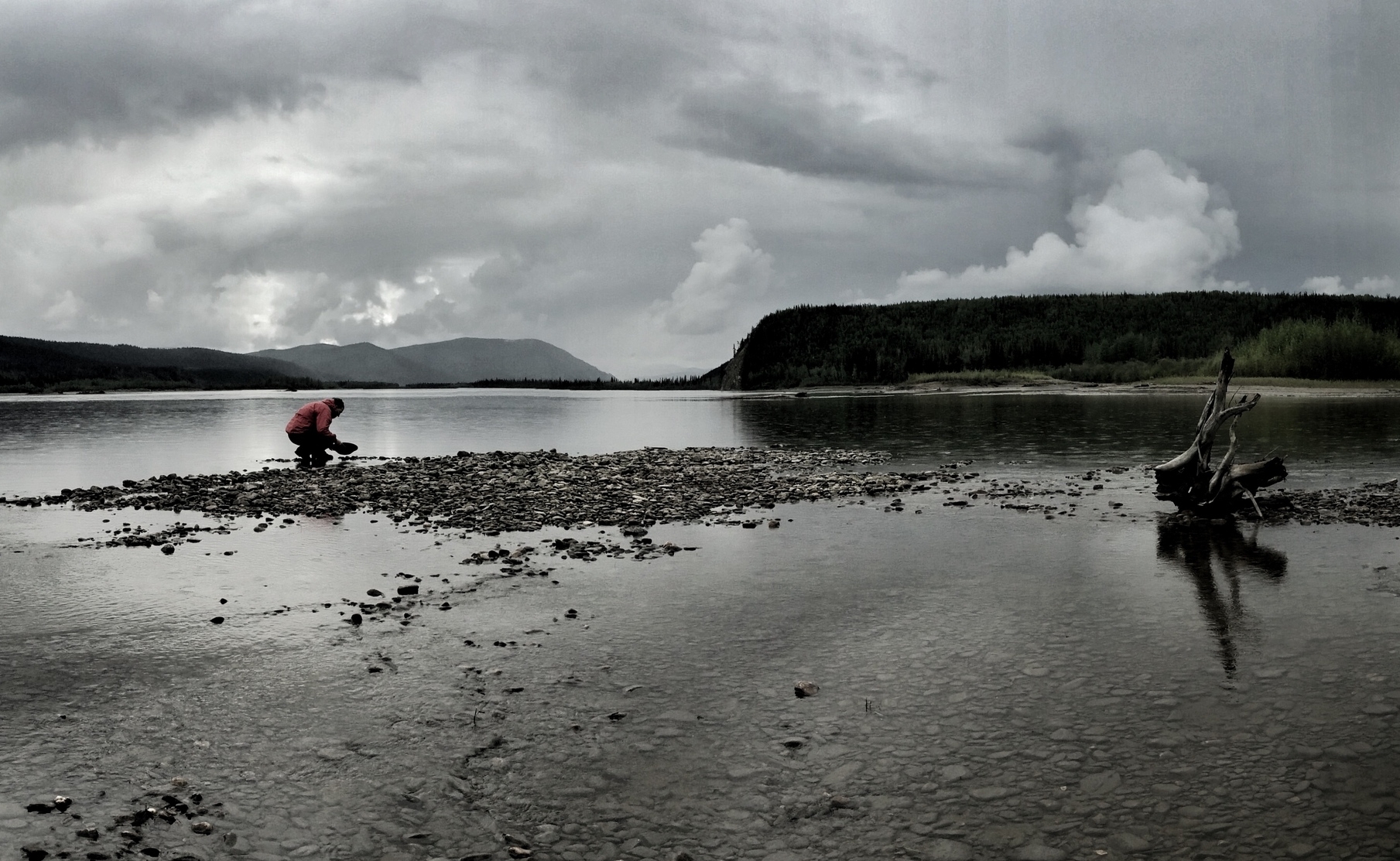
Yukon River, Canada
Photo Credit: Ryan Atkinson
We were still a long way from the Klondike gold fields further up river but I couldn't resist scooping up a pan of dirt from the riverbank and giving it a go. As the dirt sifted down to black sand, I gazed into the bottom of the pan as if seeing my future there. Panning for gold turned out to be addictive - I certainly caught gold fever in the Yukon.

Wahlbergoya, Svalbard
We were looking for walrus but I soon learnt that, in fact, Walrus always find you, if you can wait long enough.
Sitting in a small boat, watching the waves, I heard an unmistakable snort of air and water behind me. I turned to find three monstrous heads raised out of the water like periscopes - water dripping from yellowed tusks, nostrils flared, eyes bright red. They looked at me for a moment, bobbing above the waves and then were gone.

Sugar Dunes, Oman
Photo credit: Gísli Jónsson
Sand or snow? Tell the truth, did you have to look twice?
These idyllic, spotlessly white sand dunes are found on the coast of Oman and provided the perfect backdrop for the Middle-East training meet of the Euro-Arabian North Pole Expedition.
Many times while skiing in a polar desert I've thought that if I concentrated I could make myself believe that I was on a perfect desert-island beach of white sand...now that daydream came true!
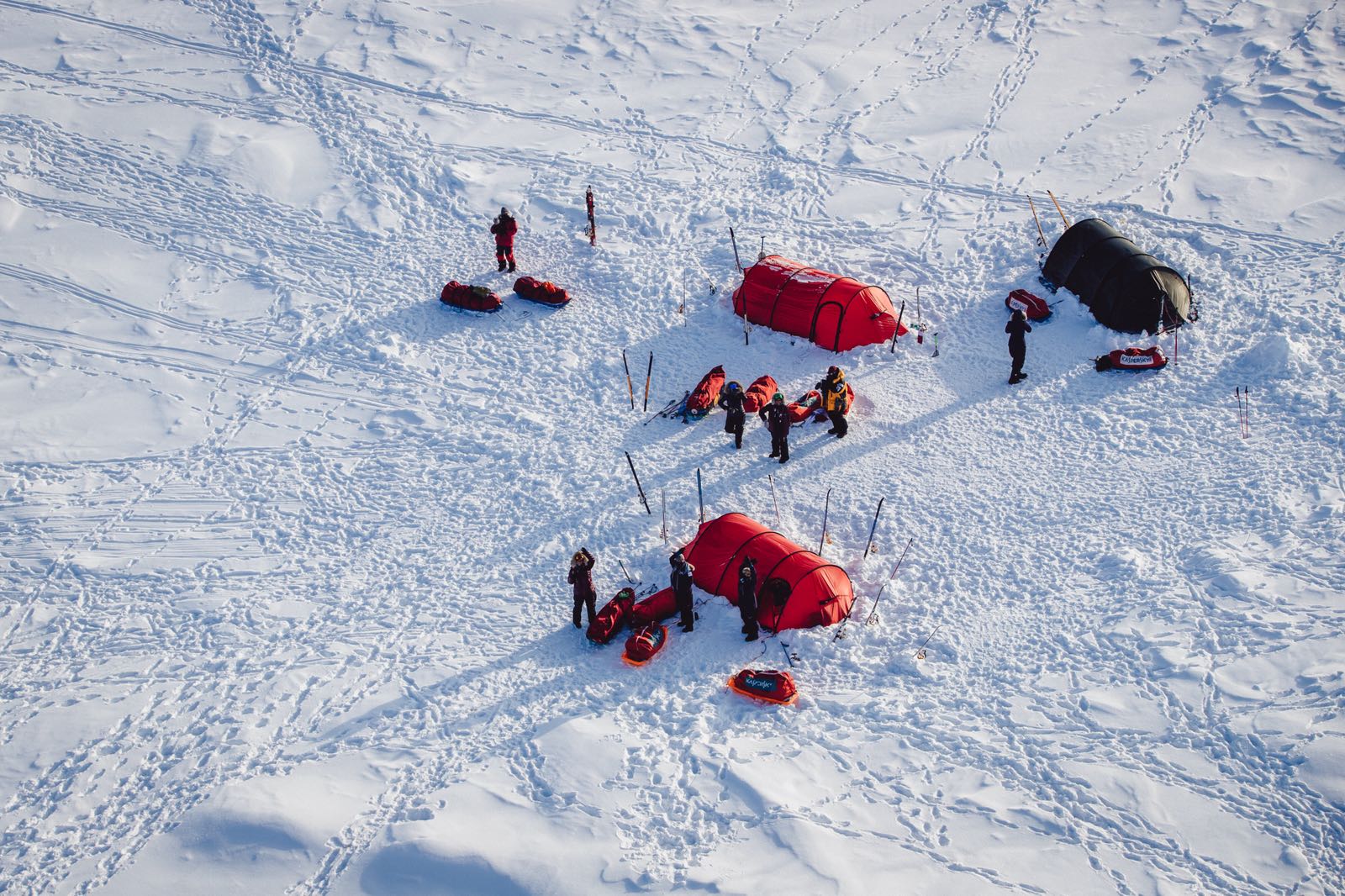
North Pole, Arctic Ocean
Photo Credit: Kaspersky Lab
We reached the North Pole on the 21st April 2018 and pitched camp on the very top of the world. By the next day, as the helicopter arrived to take us home (and to take this picture of us from the air) we had already drifted three or four kilometers southwards.
Moving as we slept was a unique feature of travelling on the Arctic Ocean Sea Ice, a constant reminder - as if any was needed - that we were not on solid ground but standing on a thin skin of frozen water.

The Chadar, Zanskar River, Ladakh, India
‘Chadar’ means blanket in the local language and is the name given to the layer of ice that forms over the Zanskar River in winter, tranforming fast-flowing rapids into a slippery highway for a few months a year.
During winter the Chadar is the only link between the tiny Himalayan Kingdom of Zanskar and the outside world.

South Shetland Islands, Antarctica
At first glance, it looks like a rocky shore - but look again! Those aren’t all rocks, but Adelie and Gentoo penguins sitting on nests. This is the outer reaches of a vast colony covering the hillsides of the island just out of shot to the right.
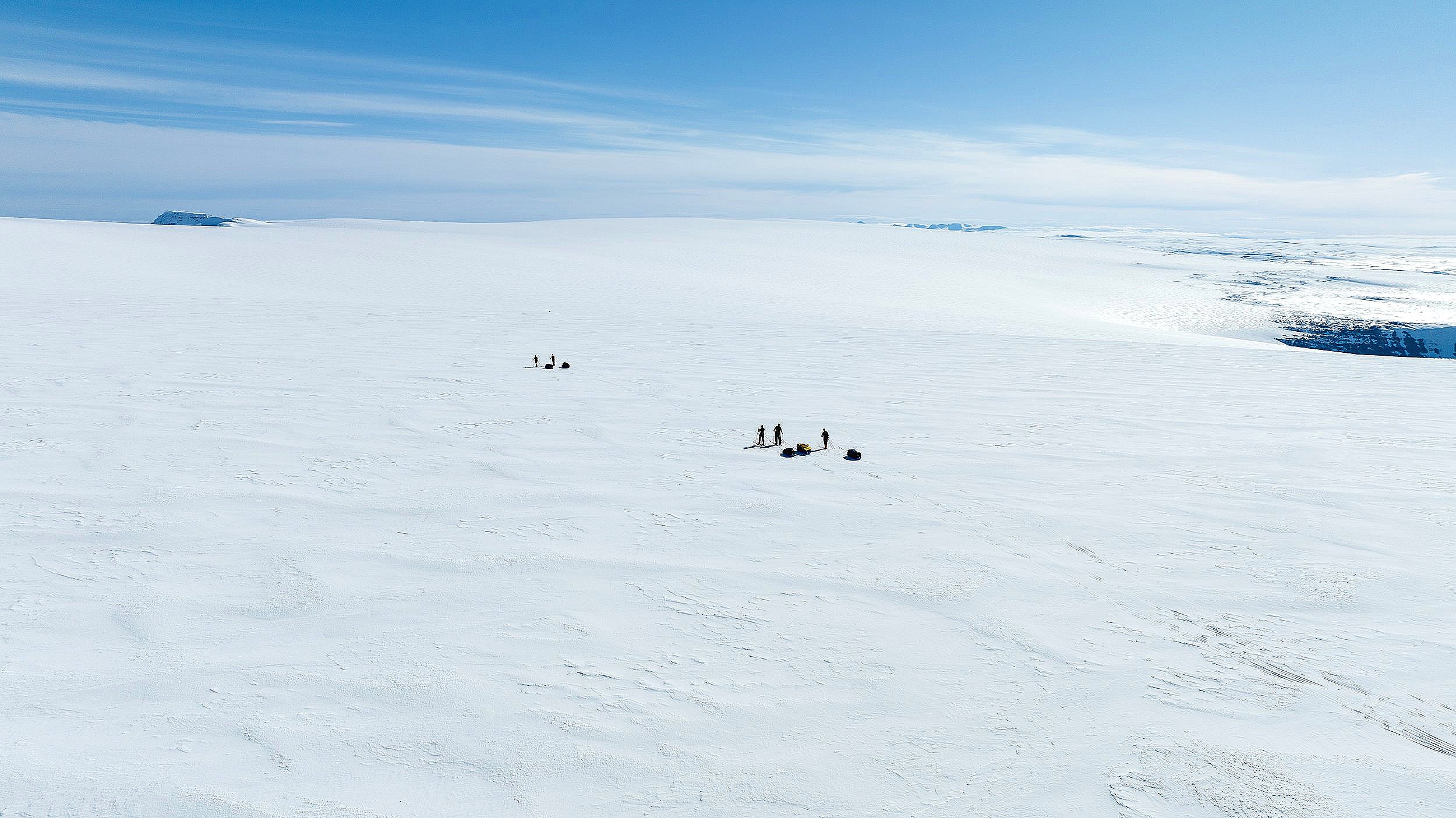
Drangajokull, Iceland
Photo Credit: Julie Moniere
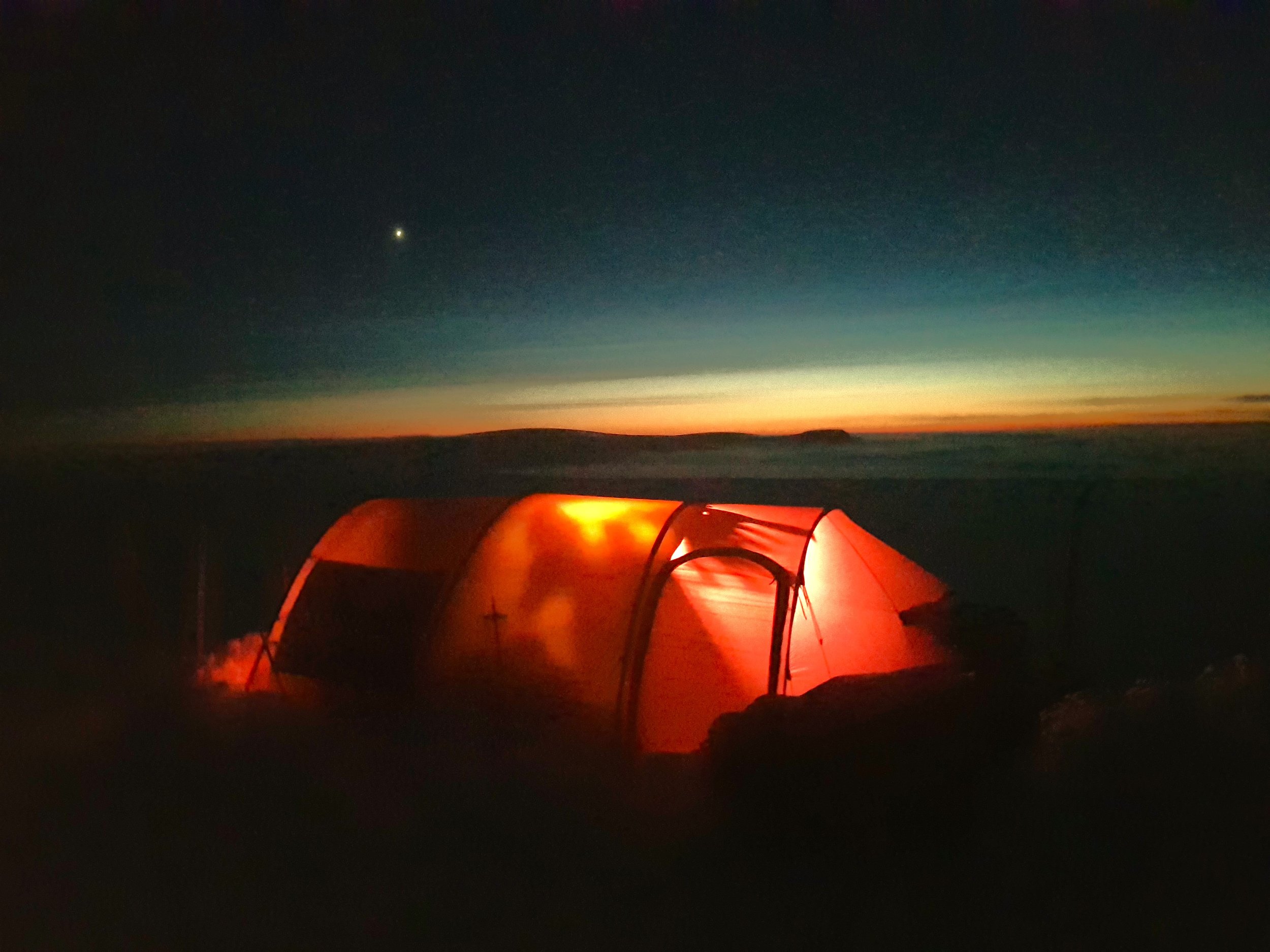
Drangajokull, Iceland
It was the stillest of evenings but we received news that high winds were going to sweep in from the southeast by dawn. The orientation of our tent meant that these winds would strike the broadest side of our shelter and we risked it being damaged.
Despite having done a thorough job of digging in the tents and building protective walls of snow, we got out the tent, dug up all the anchors and turned our tents 90 degrees.
Just as taking an umbrella guarantees there will be no rain, turning our tents guaranteed the forecast winds never arrived :(

Sun Dogs, Halos and Diamond Dust, Ellef Rignes Island, Nunavut
I know all the science behind such displays as this - but still, it seems inconceivable to me that such phenomenon could be anything but magic…

Resolute Bay, Nunavut
After a week of waiting we finally received the call to the plane. There was the slimmest of weather windows that gave us just enough possibility of making it to our destination that the pilots were prepared to give it a try.

Queen Elizabeth Islands, Nunavut, Canada
The play of light on ice and snow at the meeting of land and sea - photographed from the air.

Arctic Ocean, Nunavut, Canada
Standing alone outside the tent watching the horizon for any sign of movement that might indicate a bear, I witnessed the sun set (as much as it does this far north) and rise again through the gathering cloud.

Sea Ice forming in the Arctic Ocean
Looking more like cloud forming than ice, the patterns and textures created by the ocean surface in the stages of freezing is completely unexpected and utterly mesmerising...
Memories and Experiences shared...
















































